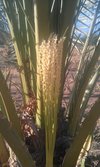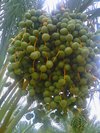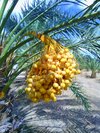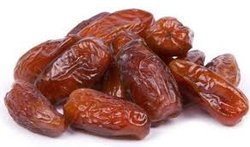The Growth Stages of the date
The growth and development of date palm fruit involves several external and internal changes. These changes are often classified on the basis of change in colour and chemical composition of the fruit, as five (5) distinct stages of fruit development, known as Hababuk, Kimri, Khalal, Rutab and Tamar.
|
Hababuk stage In general dates take about 7 months from the time they first emerge from the spath or casing until they are fully ripened.They like very hot, dry weather and lots of water on their roots In the hababuk stage, dates are hand pollinated, we are trying a couple different methods in doing this (pollinating is labour intensive) - main method is by after removing the spathe (hard covering, envelope) from around the cluster of flowers, the flower cluster is inserted into a brown paper bag - bottom of bag tied to keep pollen around the flower - using a dusting bottle we sprinkle male pollen over the top of the flower cluster, finally we staple the top of the bag and give the flower/bag a good shake - hopefully then we have even distribution of the male pollen over the female flower cluster. Pollination- this usually happens in Australia September to October - when hopefully temperature is favourable to pollinating the date, we have an added advantage - certain varieties of Dates are flowering in Autumn (Barhee at this stage, reports of other varieties having double flower), while harvest is in full swing the palm is flowering as well, luckily that has been replicated in the male palms with up to 4 flowerings a year - allowing us to store pollen for when needed. |  |
|
Kimri stage (green stage) At this stage the fruit is quite hard, the colour is apple green and it is not suitable for eating. This stage lasts from a small green berry to an almost full sized green date. It is the longest stage of growth and development of dates and lasts a total of nine to fourteen weeks, depending on varieties. Early Kimri stage while still in the paper bag we tie the bunches to a frond, this positions the bunch and hopefully minimise any damage to the fruit In late kimri or early Khalaal, the fruit bunches are bagged, this keeps the ripening dates protected from rain. birds and sun burn. This is done with a paper wrap or nylon mesh bag. |
 |
|
Khalal stage (colour stage) The fruit is mature, hard and the colour changes completely from green to greenish yellow, yellow, pink, red or scarlet depending on the variety. It lasts three to five weeks depending on varieties, where the date fruit reaches its maximum weight and size, sugar is rapidly increasing associated with a decrease in water content (around 50-85 % moisture content). The date fruit accumulates most of their sugar, both the sucrose and reducing sugar type, as sucrose during the Khalal stage. In the khalaal stage a few varieties can be harvested and eaten in their hard yellow or red state, but most kinds are totally astringent, like an unripe persimmon, the photo shows a bunch of Barhee dates in the Khalal stage (predominant date in our garden at this stage).
|  |
|
Rutab stage (meaning wet, soft ripe stage) Mostly Australians would know of dates at this stage of ripeness, the plump, sweet and juicy medjools (mostly imported from USA or Mexico) you see in your local supermarket. |  |